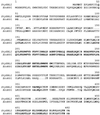Families of restriction enzymes: an analysis prompted by molecular and genetic data for type ID restriction and modification systems
- PMID: 11600708
- PMCID: PMC60208
- DOI: 10.1093/nar/29.20.4195
Families of restriction enzymes: an analysis prompted by molecular and genetic data for type ID restriction and modification systems
Abstract
Current genetic and molecular evidence places all the known type I restriction and modification systems of Escherichia coli and Salmonella enterica into one of four discrete families: type IA, IB, IC or ID. StySBLI is the founder member of the ID family. Similarities of coding sequences have identified restriction systems in E.coli and Klebsiella pneumoniae as probable members of the type ID family. We present complementation tests that confirm the allocation of EcoR9I and KpnAI to the ID family. An alignment of the amino acid sequences of the HsdS subunits of StySBLI and EcoR9I identify two variable regions, each predicted to be a target recognition domain (TRD). Consistent with two TRDs, StySBLI was shown to recognise a bipartite target sequence, but one in which the adenine residues that are the substrates for methylation are separated by only 6 bp. Implications of family relationships are discussed and evidence is presented that extends the family affiliations identified in enteric bacteria to a wide range of other genera.
Figures



Similar articles
-
KpnAI, a new type I restriction-modification system in Klebsiella pneumoniae.J Mol Biol. 1997 Aug 22;271(3):342-8. doi: 10.1006/jmbi.1997.1202. J Mol Biol. 1997. PMID: 9268663
-
KpnBI is the prototype of a new family (IE) of bacterial type I restriction-modification system.Nucleic Acids Res. 2004 Oct 8;32(18):e138. doi: 10.1093/nar/gnh134. Nucleic Acids Res. 2004. PMID: 15475385 Free PMC article.
-
Tetra-amino-acid tandem repeats are involved in HsdS complementation in type IC restriction-modification systems.Microbiology (Reading). 2003 Nov;149(Pt 11):3311-3319. doi: 10.1099/mic.0.26497-0. Microbiology (Reading). 2003. PMID: 14600243
-
Defining domains in type-I restriction and modification enzymes.Gene. 1988 Dec 25;74(1):239-41. doi: 10.1016/0378-1119(88)90295-8. Gene. 1988. PMID: 3074012 Review. No abstract available.
-
Type I restriction systems: sophisticated molecular machines (a legacy of Bertani and Weigle).Microbiol Mol Biol Rev. 2000 Jun;64(2):412-34. doi: 10.1128/MMBR.64.2.412-434.2000. Microbiol Mol Biol Rev. 2000. PMID: 10839821 Free PMC article. Review.
Cited by
-
Interaction of the ocr gene 0.3 protein of bacteriophage T7 with EcoKI restriction/modification enzyme.Nucleic Acids Res. 2002 Sep 15;30(18):3936-44. doi: 10.1093/nar/gkf518. Nucleic Acids Res. 2002. PMID: 12235377 Free PMC article.
-
Highlights of the DNA cutters: a short history of the restriction enzymes.Nucleic Acids Res. 2014 Jan;42(1):3-19. doi: 10.1093/nar/gkt990. Epub 2013 Oct 18. Nucleic Acids Res. 2014. PMID: 24141096 Free PMC article.
-
An investigation of the structural requirements for ATP hydrolysis and DNA cleavage by the EcoKI Type I DNA restriction and modification enzyme.Nucleic Acids Res. 2011 Sep 1;39(17):7667-76. doi: 10.1093/nar/gkr480. Epub 2011 Jun 17. Nucleic Acids Res. 2011. PMID: 21685455 Free PMC article.
-
Alleviation of restriction by DNA condensation and non-specific DNA binding ligands.Nucleic Acids Res. 2004 Nov 1;32(19):5841-50. doi: 10.1093/nar/gkh918. Print 2004. Nucleic Acids Res. 2004. PMID: 15520467 Free PMC article.
-
Removal of a frameshift between the hsdM and hsdS genes of the EcoKI Type IA DNA restriction and modification system produces a new type of system and links the different families of Type I systems.Nucleic Acids Res. 2012 Nov;40(21):10916-24. doi: 10.1093/nar/gks876. Epub 2012 Sep 23. Nucleic Acids Res. 2012. PMID: 23002145 Free PMC article.
References
Publication types
MeSH terms
Substances
Associated data
- Actions
Grants and funding
LinkOut - more resources
Full Text Sources
Other Literature Sources
Molecular Biology Databases

